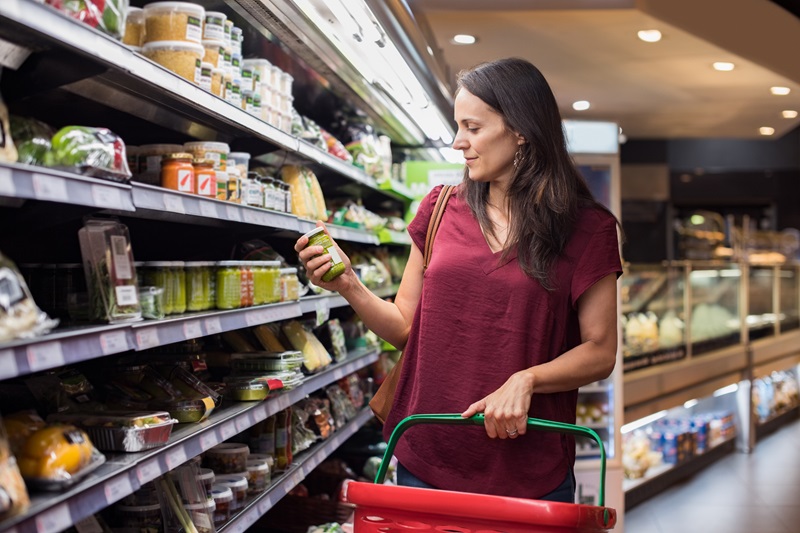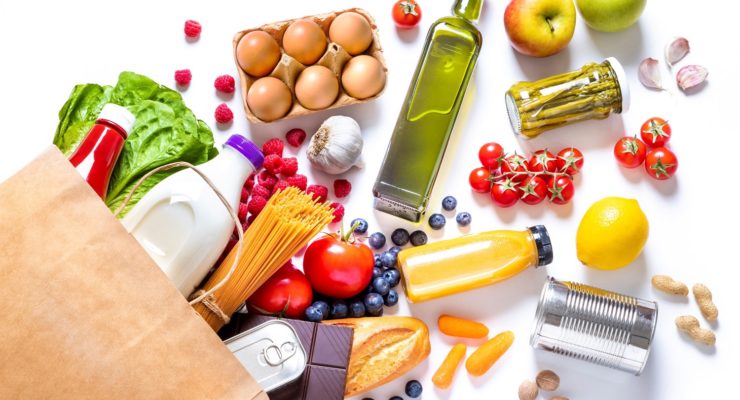Understanding meals label well being claims is a necessary talent for constructing a nutritious diet. Whereas searching for wholesome meals sounds easy, it’s something however. Meals producers typically use deceptive packaging to make their merchandise sound higher than they’re. Fads and developments additionally have an effect on what’s thought of “good” meals.
Let’s break down frequent meals claims so you’ve got the instruments to decide on the very best choices in your targets and values. With this information, you’ll confidently store for wholesome meals with out getting distracted by deceptive claims.
Forms of Label Claims

Stroll by the aisles, and also you’ll see loads of daring and vivid language on each package deal, boasting claims like “gluten-free,” “sustainable” and “no added hormones.” These messages are designed to seize your consideration and infrequently justify greater costs. Most claims fall into one in every of three classes:
- Nutrient Claims (e.g., low in fats, excessive in fiber, no added sugars)
- Ingredient Claims (e.g., natural, non-GMO, pure)
- Animal Welfare Claims (e.g., cage-free, free-range, grass-fed, antibiotic-free, hormone-free)
There are various things to think about in every class, they usually don’t all imply a lot in terms of your well being. So let’s have a look at what’s price your consideration and what you may depart on the shelf.
1. Nutrient Claims


What to know:
Nutrient claims spotlight a product’s dietary deserves and are regulated by the Meals and Drug Administration (FDA) to some extent. For instance, merchandise should meet particular standards to be labeled low-fat, low-sodium or fiber-rich.
Nevertheless, a single nutrient declare doesn’t imply your entire product is wholesome. As an example, a low-fat cracker may be excessive in added sugars. A low-carb wrap could also be excessive in protein but in addition excessive in energy and low in fiber.
Moreover, corporations typically use inventive language to suggest dietary advantages when the product might need little dietary worth.
What might be deceptive:
- Product names: Corporations can title their merchandise something they need. Names like “Protein Plus” or “Merely Good” counsel healthfulness however typically don’t differ a lot from conventional merchandise. At all times examine the vitamin info panel.
- Multigrain: Because of this a product comprises a couple of kind of grain, not essentially entire grains, and infrequently comprises refined flour as a high ingredient.
- Made with actual fruits or greens: This declare might be deceptive because the product might comprise a small share of the marketed fruit or vegetable. At all times learn the label to search out the precise share and examine the ingredient checklist.
- Made with entire grains: This declare can be utilized even when the product comprises as little as 1% entire grains.
What to search for as an alternative:
- Vitamin info panel: This part is your key to understanding which vitamins a meals product gives (and doesn’t present). The FDA gives a information that can assist you perceive every part. Evaluate merchandise facet by facet, serving dimension, energy, saturated fat, fiber, sugar and protein to choose the best choice. If following a particular meal plan like Nutrisystem, use their grocery information parameters.
- Components assertion: Components are listed so as of weight, so the primary few elements symbolize the majority of what that product is constructed from. Guarantee the primary few elements match your expectations. For instance, yogurt ought to checklist milk as the primary ingredient, not sugar.
- 100% fruit or vegetable juice: Drinks labeled 100% fruit or vegetable juice are made completely of vegatables and fruits, however might come from numerous sources.
- 100% entire grains: This declare means a product comprises a full serving or extra of entire grains, and all grains used are entire.
- Good/Glorious supply: These phrases name out the presence of wholesome vitamins, like nutritional vitamins, minerals, fiber and protein (e.g., “Good supply of fiber”). To say one thing is an effective or glorious supply means it gives 10 to twenty% or extra of your each day wants for this nutrient in every serving. Bear in mind, it doesn’t imply your entire product is wholesome, so examine the vitamin panel for the complete image.
- Decreased/Lite/Low/Free: These phrases name out the absence or discount of unhealthy vitamins like sodium, fats, sugar and ldl cholesterol (e.g., “Decreased sodium bread”). Merchandise should meet particular standards to make use of these claims. For instance, “lowered” means a product comprises 25% much less of a given nutrient than the standard model, whereas “lite” means it comprises 50% much less. Once more, this doesn’t assure a product is wholesome, so use the Vitamin Details panel to confirm.
- No Added Sugar: This declare ensures no sugar was added throughout processing however doesn’t imply the product is sugar-free, as many meals comprise pure sugars.
Key Takeaway:
Don’t depend on product names or front-of-package nutrient claims. As a substitute, give attention to the FDA-regulated vitamin info panel and ingredient assertion for correct data. Use these to check merchandise and make knowledgeable decisions.
2. Ingredient Claims


What to know:
Increasingly persons are curious about understanding the place their meals comes from and the way it’s made. Whereas that’s typically factor, it additionally means new advertising and marketing claims for ingredient high quality are actually on meals packaging.
Most of those claims don’t affect well being however might align with private preferences. Right here’s the information it’s essential to know to search out your greatest choices.
What might be deceptive:
- Clear-label: This unregulated time period varies by model and doesn’t present significant or constant details about ingredient high quality.
- No Hormones Added: The FDA approves some development hormones for cattle and lamb however not for hen, pork and different meats. Including the ‘no hormones added’ declare to those meats might be deceptive, particularly if they arrive with the next price ticket. It additionally doesn’t assure hormone-free merchandise; reasonably, it means no further hormones got, as hormones naturally happen in animals
- No Antibiotics: This declare on meat packaging tells you whether or not an animal acquired antibiotics at any level. Nevertheless, totally different variations imply various things. As an example, ‘raised with out antibiotics’ means the animal by no means acquired antibiotics, whereas ‘accountable use of antibiotics’ might imply an animal acquired antibiotics to deal with sickness however not for selling development. The World Well being Group urges producers to restrict antibiotic use in wholesome animals to fight antibiotic resistance in people. Producers should doc processes for these claims, however oversight is minimal.
- Non-GMO: This declare means that genetically modified meals (GMOs) are much less wholesome or protected than non-GMOs. Nevertheless, analysis reveals that GMOs are simply as protected and nutritious as standard meals. In actual fact, some GMOs are bred to enhance taste and vitamin.
- Pure: Each the FDA and the United States Division of Agriculture (USDA) supply some steerage on the time period ‘pure,’ however oversight and verification are restricted. USDA laws require pure meat to be free from synthetic flavors, colours, and preservatives and minimally processed. For different merchandise, the FDA’s unregulated steerage states that ‘pure’ ought to imply no artificial or synthetic elements. Nevertheless, interpretation varies extensively, and meals labeled ‘pure’ should comprise artificial elements.
- Natural: Natural meals aren’t essentially extra nutritious or protected however might align with private values. There are various kinds of natural claims. “100% natural” means your entire product is licensed natural. “Natural” means 95% of the elements are licensed natural. “Made with natural” means 70% of elements are licensed natural. Meals with lower than 70% natural elements can label which elements are natural. Bear in mind, natural doesn’t imply more healthy, so contemplate if it’s price the additional value.
- Gluten-free/Grain-free: Until you’ve got a particular allergy or intolerance, there’s nothing inherently more healthy about gluten-free or grain-free merchandise. Many are closely processed, eradicating necessary vitamins.
What to search for as an alternative:
- Minimal elements with no pointless components. Fundamental meals might be simply as handy as packaged meals with much less thriller. Embody loads of vegatables and fruits (contemporary, frozen or canned with out added seasonings), canned tuna or salmon in water, hen breast, eggs, oats, nuts, canned beans, plain rice and noodles.
- Complete meals listed first: Test that the primary three elements within the elements assertion match what you count on. For instance, a granola bar ought to comprise oats as the primary ingredient, and never corn syrup.
- Native meals sources: One of the simplest ways to get to know what’s in your meals, is to fulfill the folks rising it. Search for alternatives to affix meals co-ops in your space, if potential.
Key takeaway:
Obscure and unregulated claims similar to ‘clear label,’ ‘non-GMO’ and ‘hormone-free hen’ typically improve prices and suggest well being advantages, regardless of being no higher than commonplace, extra reasonably priced choices. Consider product high quality your self utilizing the ingredient assertion and be cautious of deceptive language utilized in these claims.
3. Animal Welfare Claims


What to know:
The therapy of animals in our meals provide issues to many individuals. Nevertheless, some claims lack readability. Right here’s the data that can assist you establish merchandise that genuinely align along with your animal welfare values.
What might be deceptive:
- Grass-fed: Primarily refers to beef. Some research present grass-fed beef is greater in sure vitamins, however there’s no proof it’s more healthy than standard meat. The time period is poorly outlined and controlled, and producers can use it even when solely a part of an animal’s food plan is grass.
- Pasture-raised: Implies an animal had free outside entry, but it surely’s not well-defined or regulated. The standard and quantity of area and degree of entry differ and don’t contemplate feed.
- Cage-free: Refers to egg-laying hens. Whereas not caged, they might nonetheless be in overcrowded pens with out outside entry.
- Free vary: Refers to poultry. Whereas regulated, there’s no commonplace for the way a lot outside time birds have. Plus, the sort of farming might not align with explicit breeds’ pure instincts, creating unsafe socialization.
What to search for:
- Third social gathering certifications: Dependable third-party certifications guarantee producers adhere to well-defined trade greatest practices for every breed and are commonly evaluated. Some certifications embrace:
- USDA Course of Verified
- Animal Welfare Authorised
- American Grassfed
- World Animal Partnership
- Licensed Humane
Key takeaway:
Many animal welfare claims are imprecise and poorly regulated. Search for choices which have been licensed by third-parties to make sure greatest processes for animal welfare are being maintained.
Conclusion
Navigating meals label claims might be difficult, however with the precise data, you can also make knowledgeable decisions that align along with your well being and values. Look past advertising and marketing buzzwords and give attention to dependable data such because the Vitamin Details panel, elements checklist and trusted certifications. With these instruments, you’ll confidently choose meals that help a wholesome life-style.
References:
- Vitamin C for FS and A. Label Claims for Meals & Dietary Dietary supplements. FDA. Revealed on-line February 5, 2020. Accessed Could 28, 2024. https://www.fda.gov/meals/food-labeling-nutrition/label-claims-food-dietary-supplements
- FDA. Learn how to Perceive and Use the Vitamin Details Label. FDA. Revealed on-line September 27, 2023. Accessed Could 28, 2024. https://www.fda.gov/meals/nutrition-facts-label/how-understand-and-use-nutrition-facts-label
- Middle for Veterinary Drugs. Security & Well being. U.S. Meals and Drug Administration. Revealed 2020. Accessed Could 28, 2024. https://www.fda.gov/animal-veterinary/safety-health
- Meat and Poultry Labeling Phrases | Meals Security and Inspection Service. Usda.gov. Revealed 2012. Accessed Could 28, 2024. https://www.fsis.usda.gov/food-safety/safe-food-handling-and-preparation/food-safety-basics/meat-and-poultry-labeling-terms
- FDA. GMOS and Your Well being Feed Your Thoughts.; 2022. Accessed Could 28, 2024. https://www.fda.gov/media/135280/obtain#:~:textual content=Thesepercent20studies1percent20showpercent20that
- Kuchler F, Sweitzer M, Chelius C. The Prevalence of the “Pure” Declare on Meals Product Packaging. www.ers.usda.gov. Revealed 2023. Accessed Could 28, 2024. https://www.ers.usda.gov/publications/pub-details/?pubid=106478
- USDA. Natural Labeling | Agricultural Advertising and marketing Service. Usda.gov. Revealed 2019. Accessed Could 28, 2024. https://www.ams.usda.gov/rules-regulations/natural/labeling
- Labeling Guideline on Documentation Wanted to Substantiate Animal Elevating Claims for Label Submissions (2019) | Meals Security and Inspection Service. Usda.gov. Revealed 2019. Accessed Could 28, 2024. https://www.fsis.usda.gov/tips/2019-0009
- Provenza FD, Kronberg SL, Gregorini P. Is Grassfed Meat and Dairy Higher for Human and Environmental Well being? Frontiers in Vitamin. 2019;6(26). doi:https://doi.org/10.3389/fnut.2019.00026



